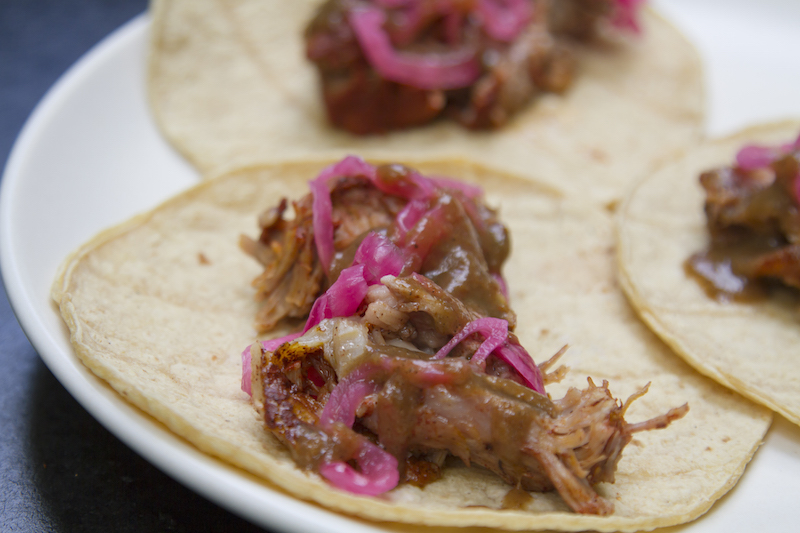
INGREDIENTS
- 1/2 of a 3.5-ounce package prepared achiote seasoning
- 1/2 cup lime juice (divided use)
- 1/4 cup orange juice
- Salt
- 1/2 of a 1 pound package banana leaves, defrosted if frozen (optional)
- 3 pounds boneless pork shoulder roast
- 1 large red onion, thinly sliced
- About 1/2 cup roasted-chile salsa or bottled habanero hot sauce (I like Yucateco and Frontera brands)
INSTRUCTIONS
Place the half package of achiote seasoning in a small bowl, pour in ½ cup of the lime juice and 2 teaspoons salt, then use the back of a spoon to work the two together into a smooth, thickish marinade.
Marinating the meat. In a large bowl or large plastic food bag combine meat and marinade, turning the meat to coat it evenly. (Though achiote has tenacious coloring properties, I suggest you do this quickly with your hands.) For the greatest penetration of flavor, let the meat marinate refrigerated (covered if in a bowl) for several hours, or even overnight.
Slow-grilling the pork. Heat a gas grill to medium-low (approximately 300 degrees) or light a charcoal fire and let it burn just until the coals are covered with gray ash and very hot. If using a kamado cooker, bring the temperature to a steady 300 degrees. Using scissors, cut off the hard edge you’ll find on most banana leaves (where the leaf attached to the central rib). Cut 3 sections of banana leaf, each about 1 foot longer than the length of a large roasting pan. Line the bottom and sides of the roasting pan with the leaves, overlapping them generously and letting them hang over the edges of the pan. Lay the meat in the pan, drizzle with all the marinade. Fold in the banana leaf edges over the meat. Cut 3 more sections of banana leaf slightly longer than the pan. Lay them over the top of the meat, again generously overlapping; tuck them in around the sides. Pour 4 cups of water into the pan. When the grill is ready, either turn the burner(s) in the center to medium-low or bank the coals of the grill for indirect cooking.
For the charcoal grill, set the grill grate in place. Set the pan on the grill grate and close the grill cover. On a kamado cooker, place the pan on the grill grate (or even directly atop the ceramic plate setter.) Grill until the meat is thoroughly tender and reaches about 205 degrees, usually about 4-5 hours. If your grill has a thermometer, aim to keep the temperature at 300 degrees. To maintain an even temperature with charcoal, add more charcoal regularly (usually a few pieces every half hour or so).
Simple pickled onions. While the meat is cooking, prepare the onions. Scoop the onions into a non-aluminum bowl. Pour boiling water over them, wait 10 seconds, then pour the onions into a strainer. Return the drained onions to the bowl, pour on the remaining ¼ cup lime juice and stir in 1 1/2 teaspoons salt. Cover and set aside until serving time.
Serving. Remove the top banana leaves. Tip the pan to accumulate the juices in one end and spoon off the fat. Season with more salt if necessary.You may want to remove the bones and cut the large pieces of meat into manageable serving sizes, but I suggest you leave everything right in the roasting pan for serving. Set out your cochinita pibil with a large fork and spoon (for spooning up all those juices). Drain the red onions and set out in a serving bowl to top each portion, along with the salsa to cautiously dab on each portion.
Working Ahead: If you’re the plan-ahead type, make the marinade on Day 1, reblend it and marinate the meat on Day 2 and then slow-roast the meat for serving on Day 3. The marinade will hold for a week or more in the refrigerator. Once the pork is marinated, cook it within 24 hours. The finished dish will keep for a couple of days, covered and refrigerated (meat and juice only—no banana leaves), though the texture of the meat won’t be quite as nice as fresh-from-the-oven. Warm refrigerated cooked meat slowly (a 300 degree oven) in the juice, covered. Pickled onions will keep for a week or so in the refrigerator, well covered.
Variation: The pork can be baked in a 325 degree oven instead of on the grill; cover the meat rather loosely with foil before baking.




